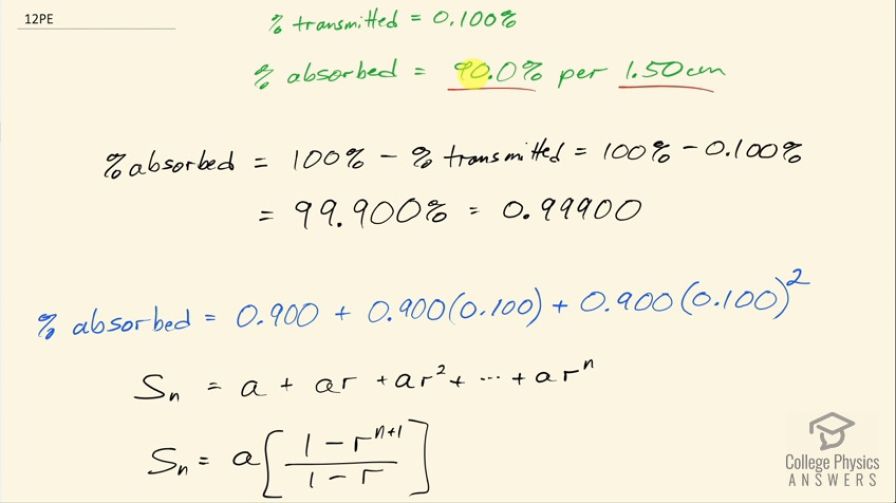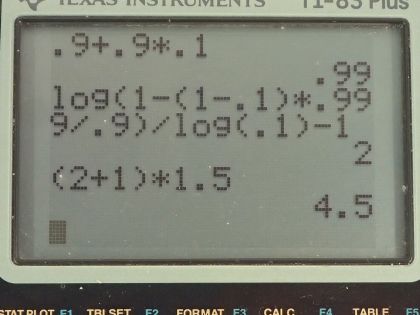Question
If a 1.50-cm-thick piece of lead can absorb 90.0% of the rays from a radioactive source, how many centimeters of lead are needed to absorb all but 0.100% of the rays?
Final Answer
Solution video
OpenStax College Physics for AP® Courses, Chapter 31, Problem 12 (Problems & Exercises)

vote with a rating of
votes with an average rating of
.
Calculator Screenshots
Video Transcript
This is College Physics Answers with Shaun Dychko. A 1.50 centimeter thick piece of lead can absorb 90 percent of the gamma rays that hit it and the question is how many centimeters of lead are needed to absorb all but 0.100 percent of the gamma rays which is to say 0.100 percent transmits through a large chunk of lead and the question is how thick should that chunk be? We can also express this percent transmitted in terms of percent absorbed say. So we have 100 percent minus the amount transmitted works out to 99.900 percent is absorbed or as a fraction that's 0.99900. We can also write the percent absorbed as this geometric series where this term here represents the fraction absorbed in the first slab of lead so this is a 1.50 centimeter chunk of lead and it would absorb 90 percent of the gamma rays that hit it. And then there will be a second chunk of lead, which is represented by this second term and only 10 percent of the gamma rays that were originally hitting the first slab will reach the second slab. So to say that this first slab absorbs 90 percent is also to say that it transmits 10 percent. So 10 percent will hit this second slab and 90 percent of that will get absorbed. And then there will be a third slab and only 10 percent of the 10 percent that reach the second slab will get to the third slab and that's the same as saying 0.100 squared— that's 10 percent of 10 percent; 90 percent of which will get absorbed— and I write this geometric series like this in order to create a formula for the percent absorbed in terms of the number of slabs and then once we'll get a formula that we can solve for the number of slabs and then multiply that by 1.50 centimeters per slab to get the thickness. So this is a geometric series and the word geometric series means that each term is found by multiplying by some common ratio which is the letter r— this is the formula that you will see in a math class, where r is this common ratio; if you divide one term by the term before it, the answer is always r— and it's the number that you multiply to get from one term to the next. Now the first term is letter a so the first term is 0.900 and r is 0.100 and this series written this way has the last term r to the power of n. We want to know how many slabs there are and the number of slabs will be 1 more than n because we want to know how many terms there are and there are n plus 1 terms here because this is counting from zero... this is r to the power of 0, you might say and here's r to the power of 1 and r to the power of 2 up till n and if suppose this is n is 2, we have one, two, three terms here. Okay so and there we go! The number of slabs is n plus 1. So this formula here says the first term gets multiplied by 1 minus the common ratio to the power of n plus 1 divided by 1 minus the common ratio and this is the total of the series, which is the percent absorbed which we know is 0.99900. So r is 0.100, a is 0.900 n is the number of slabs minus 1 or the number of slabs, in other words, is n plus 1 and S n—the sum of this—is the total fraction is the total fraction absorbed, which is 0.99900 so now we have some algebra to do to solve for n. We'll divide both sides by a and so the sum over the first term equals 1 minus the common ratio to to the power of n plus 1 and then multiply both sides by 1 minus r and then switch the sides around and then you get this line here and then add r to the power of n plus 1 to both sides and then subtract this term from both sides and then switch the sides around and we have r to the n plus 1 equals 1 minus 1 minus r times S n over a. Then we take the logarithm of both sides and doing this means that we can the power rule for logarithms says that we can take this exponent of the argument and write it as a factor outside the logarithm. So we have n plus 1 times log of r and that equals logarithm of the right hand side and then divide both sides by log of r and you have n plus 1 equals all of this and then subtract 1 from both sides to solve for n. So n then is the largest exponent in our series— it's not the number of slabs because the number of slabs is 1 more than this— so it's the logarithm of 1 minus 1 minus 0.100 times 0.99900 divided by 0.900 all divided by logarithm of 0.100 minus 1 and the answer is 2 it turns out. So the thickness then of lead that we need is going to be 1 more than this letter n times 1.50 centimeters per slab and that works out to 4.50 centimeters. So with 4.50 centimeters of lead, you would stop all but 0.100 percent of the gamma rays.
